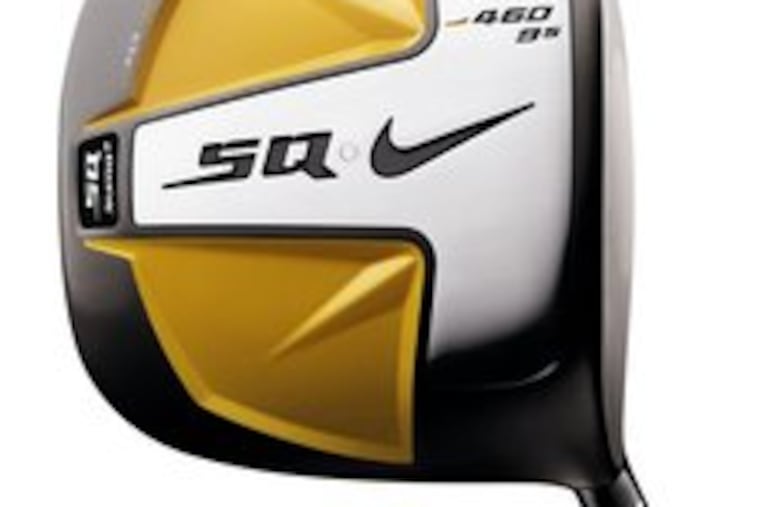On Golf | Hot gear: Square drivers
Nary a year goes by that the golf club manufacturers don't come out with something new, improved, radical or maybe only tweaked that they hope will send us running out the door to spend a few bucks to save a few strokes.

Nary a year goes by that the golf club manufacturers don't come out with something new, improved, radical or maybe only tweaked that they hope will send us running out the door to spend a few bucks to save a few strokes.
Some years, the innovations are more compelling than others. Like, say, the melon-sized 460cc titanium drivers that gave us a bigger sweet spot without adding weight. Or the perimeter-weighted irons that granted us more forgiveness and the graphite shafts that are lighter and softer in the hands. Before that, of course, steel shafts were stronger, truer than the original wood.
This year, most of the hype centers on a couple of big, stark-looking, square-headed drivers - the SQ Sumo2 from Nike and the FT-i from Callaway - that have cost millions to develop and market with a promise of more accuracy, more fairways hit.
No question, both Nike and Callaway will take all the buyers they can get, but the primary targets for the more forgiving drivers are the mid- and high-handicap players who need all the help they can get.
"You hit it long and straight," said Michelle Szynal, spokeswoman for Callaway. "For the average golfer, they should have such a problem."
Because the science behind the FT-i and the SQ Sumo2 makes them fight to correct a poorly hit shot, just as perimeter-weighted irons do, it is the rare touring professional who puts them in his or her bag.
Not only do the best players rarely mishit a shot, they also want to be able to "work" the ball - fade it or draw it - when needed. Fades and draws are exactly what these new clubs are designed to correct.
That said, ironically, it is Callaway's top player, Phil Mickelson, ranked No. 3 in the world and famous for switching out his clubs often, who occasionally packs the FT-i.
With Nike, only K.J. Choi regularly plays the SQ Sumo2, winning with it late last year at the Chrysler Championship. Nike's top player, Tiger Woods, recently practiced with the Sumo2, but he still plays the company's SasQuatch Tour.
For plenty of golf purists, before they succumb to the lure of hitting more fairways, they must first get past the idea of standing over a driver that looks more like a toaster.
Szynal, the Callaway spokeswoman, shrugs that off as a minor problem of perception.
"It's like other disruptive products in their day, like the VW Beetle, the Mac computer, fat toothbrushes," she said.
It's the need by the manufacturers to innovate in order to sell clubs that led, eventually, to this year's square clubs.
Having hit the wall on the limits imposed by the USGA on the size and spring-like effect of drivers, the manufacturers found a new frontier in "moment of inertia," or MOI, in the parlance and advertising of golf.
What's MOI? "A measure of a body's resistance to angular acceleration," or, put in layman's terms, the "twisting" of the clubhead when it hits the ball, especially on off-center hits. With the square-heads, the manufacturers are up against the limits of physics and the USGA.
"We define the box and let the manufacturers innovate within the limits of the box," said Marty Parkes, USGA spokesman. "But skill should always be the determining factor, not equipment."
MOI is not a new principle in physics, and not even in golf. In the 1960s, MOI led Karsten Solheim, an engineer and frustrated recreational golfer, to come up with a revolutionary heel-toe-weighted putter that was more forgiving and went "ping" when he struck a ball with it. Hence, the name of the successful golf company he founded, Ping. Since that day, much of golf-club design - putters, irons and drivers - has arguably descended from the MOI principle and Solheim's concept.
Frank Thomas, former longtime technical director for the USGA, doesn't quibble with the indisputable physics of MOI or the clubhead design: push the weight away from the clubface as far as possible.
But Thomas, now an equipment consultant to Golf Digest, suggests that this latest generation of square-headed drivers has stretched the MOI principle to the point of diminishing returns.
Earlier generations of drivers from a variety of manufacturers - drivers that were big and bulbous but not yet square - were already producing about as much MOI forgiveness as the physics would allow, Thomas said. For a hefty price, the FT-i ($500) and SQ Sumo2 ($400) simply squeeze out the last little bit.
"I don't want to knock it because the concept isn't bad," said Thomas, who has written extensively on MOI on his Web site, www.franklygolf.com. "But it isn't much improvement" over the last generation.
As Szynal, the Callaway spokeswoman, sees it, her company and Nike are doing only what companies in all industries do: chase the next big idea.
"The pace of innovation has increased in all products," she said. "People want bigger, better, more in all products - and they want it now. In golf, any improvement you can make helps."